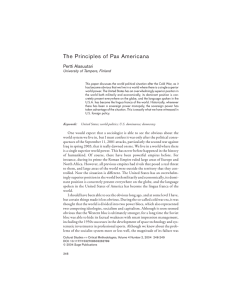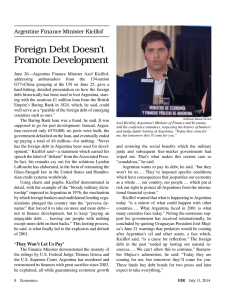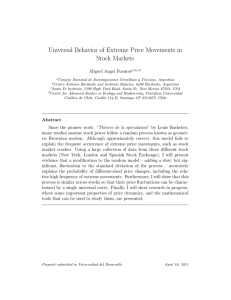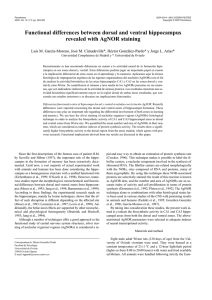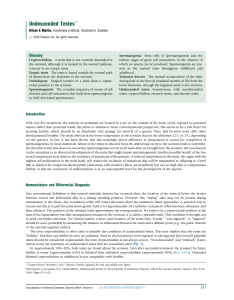Description of a new species of Tylodelphys (Digenea
Anuncio
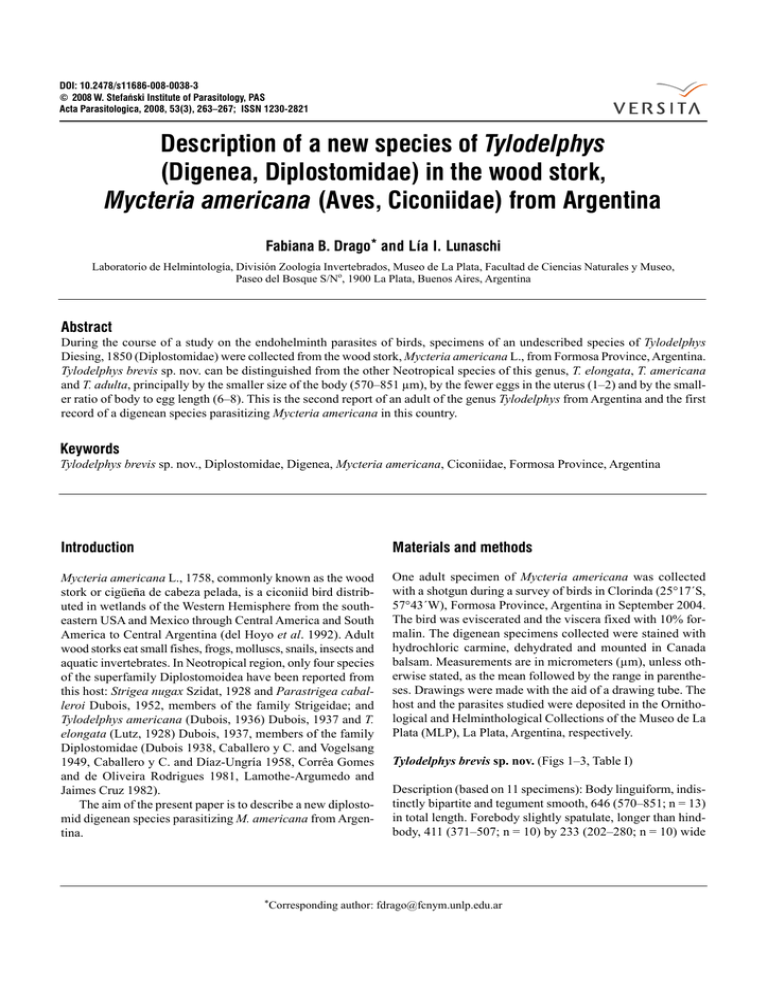
DOI: 10.2478/s11686-008-0038-3 © 2008 W. Stefañski Institute of Parasitology, PAS Acta Parasitologica, 2008, 53(3), 263–267; ISSN 1230-2821 Description of a new species of Tylodelphys (Digenea, Diplostomidae) in the wood stork, Mycteria americana (Aves, Ciconiidae) from Argentina Fabiana B. Drago* and Lía I. Lunaschi Laboratorio de Helmintología, División Zoología Invertebrados, Museo de La Plata, Facultad de Ciencias Naturales y Museo, Paseo del Bosque S/No, 1900 La Plata, Buenos Aires, Argentina Abstract During the course of a study on the endohelminth parasites of birds, specimens of an undescribed species of Tylodelphys Diesing, 1850 (Diplostomidae) were collected from the wood stork, Mycteria americana L., from Formosa Province, Argentina. Tylodelphys brevis sp. nov. can be distinguished from the other Neotropical species of this genus, T. elongata, T. americana and T. adulta, principally by the smaller size of the body (570–851 µm), by the fewer eggs in the uterus (1–2) and by the smaller ratio of body to egg length (6–8). This is the second report of an adult of the genus Tylodelphys from Argentina and the first record of a digenean species parasitizing Mycteria americana in this country. Keywords Tylodelphys brevis sp. nov., Diplostomidae, Digenea, Mycteria americana, Ciconiidae, Formosa Province, Argentina Introduction Materials and methods Mycteria americana L., 1758, commonly known as the wood stork or cigüeZa de cabeza pelada, is a ciconiid bird distributed in wetlands of the Western Hemisphere from the southeastern USA and Mexico through Central America and South America to Central Argentina (del Hoyo et al. 1992). Adult wood storks eat small fishes, frogs, molluscs, snails, insects and aquatic invertebrates. In Neotropical region, only four species of the superfamily Diplostomoidea have been reported from this host: Strigea nugax Szidat, 1928 and Parastrigea caballeroi Dubois, 1952, members of the family Strigeidae; and Tylodelphys americana (Dubois, 1936) Dubois, 1937 and T. elongata (Lutz, 1928) Dubois, 1937, members of the family Diplostomidae (Dubois 1938, Caballero y C. and Vogelsang 1949, Caballero y C. and Díaz-Ungría 1958, CorrLa Gomes and de Oliveira Rodrigues 1981, Lamothe-Argumedo and Jaimes Cruz 1982). The aim of the present paper is to describe a new diplostomid digenean species parasitizing M. americana from Argentina. One adult specimen of Mycteria americana was collected with a shotgun during a survey of birds in Clorinda (25°17´S, 57°43´W), Formosa Province, Argentina in September 2004. The bird was eviscerated and the viscera fixed with 10% formalin. The digenean specimens collected were stained with hydrochloric carmine, dehydrated and mounted in Canada balsam. Measurements are in micrometers (µm), unless otherwise stated, as the mean followed by the range in parentheses. Drawings were made with the aid of a drawing tube. The host and the parasites studied were deposited in the Ornithological and Helminthological Collections of the Museo de La Plata (MLP), La Plata, Argentina, respectively. *Corresponding Tylodelphys brevis sp. nov. (Figs 1–3, Table I) Description (based on 11 specimens): Body linguiform, indistinctly bipartite and tegument smooth, 646 (570–851; n = 13) in total length. Forebody slightly spatulate, longer than hindbody, 411 (371–507; n = 10) by 233 (202–280; n = 10) wide author: [email protected] 264 Fabiana B. Drago and Lía I. Lunaschi Œl¹ski Figs 1–3. Tylodelphys brevis sp. nov. from Mycteria americana: 1. Holotype, entire worm, ventral view. 2. Enlarged dorsal view of proximal female genitalia. 3. Enlarged lateral view of terminal genitalia. Scale bars = 100 µm (1), 50 µm (2, 3). Abbreviations: ag – genital atrium, at – anterior testis, e – egg, gc – genital cone, gp – genital pore, hd – hermaphroditic duct, Lc – Laurer’s canal, Mg – Mehlis’ gland, o – ovary, pt – posterior testis, rv – vitelline reservoir, sv – seminal vesicle, u – uterus at acetabular level. Hindbody conical, 248 (174–343; n = 10) long by 210 (169–275; n = 10) wide at anterior testis level. Oral sucker subterminal, 56 (40–67; n = 12) long by 56 (44– 69; n = 12) wide, always larger than ventral sucker. Ventral sucker pre-equatorial, 31 (24–36; n = 11) long by 40 (27–54; n = 11) wide. Sucker width ratio, 1:1.4 (0.9–2). Distance between ventral sucker and anterior extremity, 245 (207–300; n = 9). Pseudosuckers well developed, reniform, 60 × 43 (48– 74 × 29–59; n = 11), 9.4% (7.7–11.3%) of body length. Holdfast organ round to elliptical with median slit, 93 × 75 (69–131 × 50–102; n = 9), 14.5% (10.2–19%) of body length. Distance between ventral sucker and holdfast organ, 31 (17–48; n = 10). Prepharynx absent; pharynx large, 50 × 28 (45–57 × 22–31; n = 10), oesophagus short, 13 (10–15; n = 5), caeca slender extending to anterior margin of copulatory bursa. Copulatory bursa not protrusible, with genital pore terminal, enclosing small genital cone and hermaphroditic duct. Testes tandem, extended transversally occupying whole width of hindbody; anterior testis, 52 × 183 (41–71 × 133–226; n = 8); posterior testis 49 × 155 (34–83 × 121–202; n = 9). Ovary round to oval, to right of middle line, pretesticular, 44 × 56 (34–53 × 29–78; n = 8). Laurer’s canal short, opening laterally to ovary on dorsal surface; Mehlis’ gland lateral to anterior testis. Uterine seminal receptacle present. Vitellarium follicular, in fore- and hindbody; in forebody extend from nearly midway between intestinal bifurcation and ventral sucker, follicles scarce ante- *Calculated Localities References Argentina present study 0.4–0.8 0.9–2 9–13 0.8–1.9 1–1.5 5.3–9.8 3.3–5.9 0.8–1.4 6–8 Mycteria americana L. 207–300 17–48 570–851 371–507 ×202–280 174–343 × 169–275 40–67 × 44–69 24–36 × 27–54 48–74 × 29–59 69–131 × 50–102 absent 45–57 × 22–31 10–15 34–53 × 29–78 41–71 × 133–226 34–83 × 121–202 83–102 × 45–64 1–2 from descriptions given by Dubois (1970). Body length Forebody Hindbody Oral sucker Ventral sucker Pseudosuckers Holdfast organ Prepharynx Pharynx Oesophagus Ovary Anterior testis Posterior testis Eggs Egg number Distances Ventral sucker-anterior end Ventral sucker-holdfast organ Ratios Hindbody/ forebody length Sucker width Body/pseudosuckers length Pseudosuckers/oral sucker length Pseudosuckers/pharynx length Body/holdfast organ length Forebody/holdfast organ length Oral sucker/pharynx length Body/egg length Hosts T. brevis sp. nov. 19–21* Tachybaptus dominicus (L.) Jabiru mycteria (Lichtenstein) Mycteria americana Brasil, Venezuela, Cuba Dubois (1970) Dubois and Macko (1972) 2 5.8–5.9 5–5.3 0.55–0.72 (0.60) subequal 10–12 75–125 × 95–200 100–140 × 445–460 110–180 × 400–445 90–97 × 60–66 15 1.5–2.35 mm 0.800–1.12 mm × 450–520 450–650 × 43–52 80–100 × 90–104 70–90 × 99–110 110–210 × 80–130 160–210 absent 63–73 × 60–68 T. elongata Table I. Comparative measurements (ranges) of Tylodelphys species from Neotropical birds Brasil, Venezuela, México Dubois (1970) León-RPgagnon (1992) 23–28* Mycteria americana Jabiru mycteria 2.77–5.87 Argentina Lunaschi and Drago (2004) 12–16 Podiceps major (Boddaert) 5.5–8.5 13–31 1–2 0.28–0.64 1.123–1.464 mm 720–950 × 430–595 269–528 × 394–557 71–97 × 83–103 60–80 × 78–97 145–216 × 74–126 195–250 × 178–274 absent 71–110 × 53–74 25 73–83 × 73–97 120–121 × 216–494 115–168 × 211–427 87–99 × 51–59 1–20 T. adulta 0.38–0.80 0.9–2.4 mm 0.550–1.5 mm ×290–780 310–900 × 250–650 48–87 × 48–95 33–76 × 36–108 50–122 × 68–80 115–390 × 110–510 12 49–80 × 33–72 40 63–135 × 80–90 110–300 × 270–575 110–290 × 240–520 84–103 × 53–63 30 T. americana New species of Tylodelphys from M. americana Zdzis³aw 265 Stanis³a 266 Fabiana B. Drago and Lía I. Lunaschi rosbœŸæv rior to level of ventral sucker and more concentrated around holdfast organ; in hindbody few follicles in mid-ventral region. Uterus without eggs or containing 1–2 large eggs, 94 × 56 (83–102 × 45–64; n = 10), 15% (12.3–17.3%) of body length. Excretory vesicle and pore not seen. Type host: Mycteria americana L. (Aves, Ciconiiformes, Ciconiidae). Type locality: Clorinda (25°17´S, 57°43´W), Formosa Province, Argentina. Site of infection: Small intestine. Type specimens: Holotype, MLP 5741; paratypes MLP 5742. Etymology: The specific name refers to the small size of the species. Remarks: The genus Tylodelphys Diesing, 1850 was created to include species characterized by having an indistinctly bipartite body, well developed pseudosuckers, non-trilobate anterior extremity and a copulatory bursa enclosing a small genital cone with a hermaphroditic duct opening terminally. It is cosmopolitan and has been found parasitizing numerous species of falconiforms, ciconiiforms, podicipediforms, anseriforms, gaviiforms and strigiforms (Odening 1962, Dubois 1970, Niewiadomska 2002). To date, of the 14 species of Tylodelphys known worldwide, only three have been reported from Neotropical region, parasitizing podicipediform and ciconiiform birds. Tylodelphys americana (Dubois, 1936) Dubois, 1937 was found parasitizing ciconiids from Brazil and Venezuela and podicipedids from México; T. elongata (Lutz, 1928) Dubois, 1937 in podicipedid birds from Cuba, Venezuela and Brazil and ciconiid birds from Venezuela and Brazil; and T. adulta Lunaschi et Drago, 2004 in podicipedids from Argentina (Lutz 1928, Pérez Vigueras 1944, Caballero y C. and Vogelsang 1949, Travassos et al. 1969, Dubois 1970, Dubois and Macko 1972, CorrLa Gomes and de Oliveira Rodrigues 1981, LamotheArgumedo and Jaimes Cruz 1982, León-RPgagnon 1992, Lunaschi and Drago 2004). Utilizing the descriptions given by Dubois (1970) and Lunaschi and Drago (2004) Tylodelphys brevis sp. nov. can be separated from all Neotropical species principally by having a smaller body size, by the relative size of its organs, by having few eggs in the uterus (1–2) and by a smaller body/egg length ratio (Table I). In addition, T. americana can be distinguished from the new species by having a small copulatory bursa delimited by a conspicuous constriction, by the presence of a prepharynx, by having a long oesophagus and by the more extensive distribution of vitelline follicles in the forebody, occupying 60–83% of the forebody vs. 42–54%. Tylodelphys elongata can be differentiated from the new species by the arrangement of the vitelline follicles in the forebody, which are more anteriorly distributed, occupying 75% of the forebody. Tylodelphys adulta differs from T. brevis sp. nov. by the distribution of vitelline follicles, which never reach anteriorly to the ventral sucker, by having larger pseudosuckers, by the presence of minute spines on the forebody and oral sucker and by a smaller body length/pseudosuckers length ratio. fjad kadsææ¿æ In addition, Dubois (1978) described specimens collected from Busarellus nigricollis (Latham) (Accipitridae) from Colombia as Diplostomum (Tylodelphys) sp., providing no detailed drawings of them. These specimens are similar in size to the specimens described here (body 760–900 × 260–300, oral sucker 48–55 × 54–63, ventral sucker 42–50 × 50–57, pseudosuckers 57–73 × 31–45, holdfast organ 80–115 × 80– 120, pharynx 37–47 × 34–37, ovary 40–42 × 100–110, anterior testis 75–95 × 165–210, posterior testis 100–125 × 140– 200), but differ in the distribution of the vitelline follicles in the forebody, which extend to the level of the intestinal bifurcation. The life cycles of Tylodelphys species include fishes and amphibians as second intermediate hosts. No full life cycle have been studied in Argentina. However, metacercariae of six species of Tylodelphys have been described naturally parasitizing the brain, pericardial cavity or visceral cavity of freshwater fishes: Tylodelphys destructor Szidat et Nani, 1951, T. barilochensis Quaggiotto et Valverde, 1992, T. crubensis Quaggiotto et Valverde, 1992, T. argentinus Quaggiotto et Valverde, 1992, T. jenynsiae Szidat, 1969 and T. cardiophilus Szidat, 1969 (Szidat and Nani 1951, Szidat 1969, Quaggiotto and Valverde 1992, Ortubay et al. 1994, Flores and Baccalá 1998). Of the six species mentioned above, only T. jenynsiae and T. cardiophilus share their geographical distribution with the new species. Unfortunately, is not possible to compare them with T. brevis sp. nov. because their adults are unknown. Acknowledgements. Special thanks are due to Dr. C. Montoya for help and hospitality during our stay in Formosa Province, to Dr. C. Darrieu of Sección Ornitología (División Zoología Vertebrados, Museo de La Plata). The Dirección de Fauna y Parques (Ministerio de la Producción) of Formosa Province authorized the collection of birds. The authors, Lía Lunaschi and Fabiana Drago are members of the Comisión de Investigaciones Científicas de la provincia de Buenos Aires (CIC) and Universidad Nacional de La Plata (UNLP), respectively. The present study was funded by CIC (File 2157-119 40/4; Res. No 044). References Caballero y C.E., Díaz-Ungría C. 1958. Intento de un catálogo de los tremátodos digéneos registrados en territorio venezolano. Memoria de la Sociedad de Ciencias Naturales La Salle, 18, 19–36. Caballero y C.E., Vogelsang E.G. 1949. Fauna helmintológica venezolana. II. Algunos tremátodos de aves y mamíferos (1). Revista de Medicina Veterinaria y Parasitología, 8, 43–65. CorrLa Gomes D., Oliveira Rodrigues H. 1981. Trematoda. In: (Eds. S.H. Hurlbert and A. Villalobos Figueroa) Aquatic Biota of Mexico, Central America and the West Indies. San Diego State University, California, 116–128. del Hoyo J., Elliot A., Sargatal J. 1992. Handbook of the birds of the world. Vol. I. Lynx, Barcelona, 696 pp. Dubois G. 1938. Liste systématique des Strigéides du Brésil et du Venezuela. Livro Jubilar do Professor Lauro Travassos, 145– 155. Dubois G. 1970. Synopsis des Strigeidae et des Diplostomatidae (Trematoda). Mémoires de la Société Neucha$ teloise des Sciences Naturelles, 10, 259–727. New species of Tylodelphys from M. americana Dubois G. 1978. Notes Helminthologiques. IV. Strigeidae Railliet, Diplostomidae Poirier, Proterodiplostomidae Dubois et Cyathocotylidae Poche (Trematoda). Revue Suisse de Zoologie, 85, 607–615. Dubois G., Macko J. 1972. Contribution B l’étude des Strigeata La Rue, 1926 (Trematoda: Strigeida) de Cuba. Annales de Parasitologie Humaine et Comprarée, 47, 51–75. Flores V., Baccalá N. 1998. Multivariate analyses in the taxonomy of two species of Tylodelphys Diesing, 1850 (Trematoda: Diplostomidae) from Galaxias maculatus (Teleostei: Galaxiidae). Systematic Parasitology, 40, 221–227, DOI: 10.1023/A:100 6070008280. Lamothe-Argumedo R., Jaimes Cruz B. 1982. Trematoda. In: (Eds. S.H. Hurlbert and A. Villalobos Figueroa) Aquatic Biota of Mexico, Central America and the West Indies. San Diego State University, California, 73–84. León-RPgagnon V. 1992. Fauna helmintológica de algunos vertebrados acuáticos de la ciénaga de Lerma, Estado de México. Anales del Instituto de Biología, Universidad Nacional de México, Zool., 63, 151–153. Lunaschi L.I., Drago F.B. 2004. Descripción de una especie nueva de Tylodelphys (Digenea: Diplostomidae) parásita de Podiceps major (Aves: Podicepedidae) de Argentina. Anales del Instituto de Biología, Universidad Nacional de México, Zool., 75, 245–252. Lutz A. 1928. Estudios de zoología y parasitología Venezolanas. Universidad Central de Venezuela, Caracas, 133 pp. Niewiadomska K. 2002. Family Diplostomidae Poirier, 1886. In: (Eds. D.I. Gibson, A. Jones and R.A. Bray) Keys to the (Accepted April 15, 2008) 267 Trematoda. Vol. 1. CABI Publishing and The Natural History Museum, Wallingford, 167–196. Odening K. 1962. Trematoden aus einheimischen Vögeln des Berliner Tierparks und der Umgebung von Berlin. Monatsberichte der Deutschen Akademie der Wissenschaften zu Berlin, 4, 228–234. Ortubay S., Semenas L., Ubeda C., Quagiotto A., Viozzi G. 1994. Catálogo de peces dulceacuícolas de la Patagonia Argentina y sus parásitos metazoos. Dirección de Pesca y Recursos Naturales. S.C. Bariloche, 110 pp. Pérez Vigueras I. 1944. Trematodes de la Super-Familia Strigeoidea; descripción de un género y siete especies nuevas. Revista de la Universidad de la Habana, 52–54, 294–314. Quaggiotto E.A., Valverde F. 1992. Nuevas metacercarias del género Tylodelphys (Trematoda, Diplostomidae) en poblaciones lacustres de Galaxias maculatus (Teleostei, Galaxiidae). Boletín Chileno de Parasitología, 47, 19–24. Szidat L. 1969. Structure, development, and behaviour of new strigeatoid metacercariae from subtropical fishes of South America. Journal of the Fisheries Research Board of Canada, 26, 753–786. Szidat L., Nani A. 1951. Diplostomiasis cerebralis del pejerrey. Revista del Museo Argentino de Ciencias Naturales Bernardino Rivadavia e Instituto Nacional de Investigación de las Ciencias Naturales, Zool., 1, 323–384. Travassos L., Teixeira de Freitas J.F., Kohn A. 1969. Trematódeos do Brasil. Memórias do Instituto Oswaldo Cruz, 67, 1–886.


